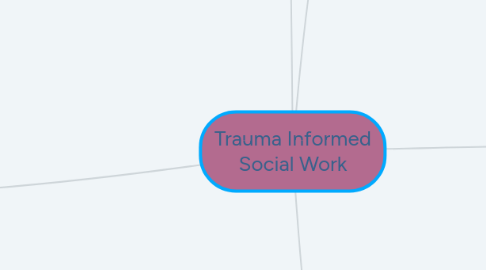
1. Practical Application
1.1. Practitioners recognise that complex trauma and the accumulation of traumatic experiences often leads to many forms of mental distress
1.2. Being respectful towards victim/survivor and understanding that presenting symptoms are adaptions/ coping strategies to deal with past untreated trauma's
1.3. Focus on Trauma informed principles (Safety/Trustworthiness/Choice/ Collaboration/Empowerment
1.4. Focus on life stabilisation, general education about trauma rather than pathologising
1.5. Practitioners must be reliable and consistent to earn their clients' trust
1.6. Attending to self care and personal wellness when necessary
1.7. Understanding the victim/ survivor in the context (sexual identity, gender, race, orientation, religious, race, or political group) and reflect on how particular contexts may have contributed and impacted the persons experience/s of trauma
1.8. (Clark et al 2015; Levenson 2017)
2. Theories
2.1. Trauma Informed
2.1.1. Non-pathologising, awareness of individual experiences and coping behaviours
2.1.2. Understanding context
2.1.3. Encourage growth and change
2.1.4. Awareness of power dynamics
2.1.5. Transparent relationship
2.1.6. (Clark et al 2015)
2.2. Person Centered
2.2.1. Perceive the world as the client sees it
2.2.2. Client can share their inner world experiences in a safe supportive and empathetic environment
2.2.3. (Connolly & Harms 2015)
2.3. Feminist Theory
2.3.1. Addressing power relations within patriarchy and male domination over women
2.3.2. Awareness of gender related trauma
2.3.3. Oppression of marginalised groups
2.3.4. Awareness of cultural roles expectations and demands that can restrict the opportunities for some women
2.3.5. Fostering strengths perspective and post traumatic growth
2.3.6. Focus on gender based narratives
2.3.7. Uy & Okubo 2018
2.4. Strengths Perspective
2.4.1. People have strengths and are motivated towards well-being and optimal functioning
2.4.2. Client led goal making
2.4.3. Work towards long term empowerment by using strengths and anti-oppressive practice
2.4.4. Resilience and capacity
2.4.5. Positive an optimistic attitudes towards service users and fully 'recognise clients capacities, resources, hopes and dreams for the future' (Healy 2014 p.169).
2.4.6. Focus on assets
2.4.7. Recognition of solution-focused approaches
2.4.8. Positive language
2.4.9. (Chenoweth & McAuliffe 2015; Conolly & Harms 2015; Healy 2014)
